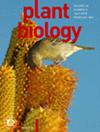探讨火对传粉媒介依赖性二聚体多态性的影响。
IF 3.6
3区 生物学
Q1 PLANT SCIENCES
引用次数: 0
摘要
火通过多种方式影响植物性状,但对花的多态性的影响尚不清楚。另一方面,长花柱(l -花柱)和短花柱(s -花柱)的花型多态性表现出互异交和自交不亲和系统,依赖于生物传粉实现花型间传粉和繁殖。我们研究了火对菊花功能的影响,评估了形态、花奖励、形态间互惠和繁殖成功率。本文研究了巴西热带稀树草原上以蜂鸟为传粉昆虫的二花丛硬纹木(Palicourea rigida, Rubiaceae)种群,方法是将受火灾影响地区的个体与未受火灾影响地区的个体进行比较。火影响了一些花性状,减少了花序(9.4%)、花冠(4.7%)、花药(5.9%)和l型柱头(33.5%)的数量。但对株高、芽数、花序数和花蜜性状无显著影响。火不影响变形间的相互作用。因此,受火或不受火影响的植物表现出相似的互易性措施,转化为两种形态相似的花粉沉积和坐果。火对s型坐果也有不同形态的积极影响(增加35.31%)。火可以诱导二花科植物的形态变化。然而,火并不影响大多数传粉者的吸引力和回报性状。生殖高度的一致性使花粉能够在火灾影响区域内和不同火灾历史的马赛克中流动。高繁殖能力与生殖能力的快速恢复有关,通过有效的形态间花粉转移,使其能够正常运作。在人为火灾日益频繁的情况下,这种植物恢复力可能对维持多态性和相关传粉媒介具有重要意义。本文章由计算机程序翻译,如有差异,请以英文原文为准。

Investigating the effects of fire on pollinator-dependent distyly polymorphism
求助全文
通过发布文献求助,成功后即可免费获取论文全文。
去求助
来源期刊

Plant Biology
生物-植物科学
CiteScore
8.20
自引率
2.60%
发文量
109
审稿时长
3 months
期刊介绍:
Plant Biology is an international journal of broad scope bringing together the different subdisciplines, such as physiology, molecular biology, cell biology, development, genetics, systematics, ecology, evolution, ecophysiology, plant-microbe interactions, and mycology.
Plant Biology publishes original problem-oriented full-length research papers, short research papers, and review articles. Discussion of hot topics and provocative opinion articles are published under the heading Acute Views. From a multidisciplinary perspective, Plant Biology will provide a platform for publication, information and debate, encompassing all areas which fall within the scope of plant science.
 求助内容:
求助内容: 应助结果提醒方式:
应助结果提醒方式:


